



NOLA Micro GRAND REFERENCE SPEAKER
PRICE:$14,000 per pair
OPTIONAL STANDS: $1,200
Review by
James L. Darby
This is the fourth brainchild from Carl Marchisotto’s Nola speakers that we have had the pleasure of reviewing. Like the elegant Baby Grand reference speakers we reviewed last year, this is also a premiere review. While the new Micro Grand could not be more different than the huge Baby Grands in terms of price and size, but the rest of the diminutive stand mount Micros are very similar indeed. In fact, according to Carl, the design goal for the Micro grand is to produce a stand-mount speaker that would produce in a smaller venue, the same "state of the art" experience that the Baby Grands produce in a larger room. That's setting a very high bar because the $55,000 Baby Grands are a true audiophile reference, though Nola does make a four cabinet model that's even “grander”.
Still it seems Carl has a point. When
I asked him about the similarities he said, “As you know when other
companies produce a high end stand mount, they usually revert to a 2 way
2 driver system. Let's say you are a Magico fan. The 2 way 2 driver
Mini stand mount is really a different animal from the 5 driver
multi-way M5. In order to get the same experience as the Baby Grands,
the Micro was formatted as a miniaturized Baby Grand. That is it uses
the same 3 1/2 way design with twin magnesium woofers, the same open
baffle Alnico magnet dipole mid range and the same custom Raven true
ribbon tweeter. These are the very same drivers used in the Baby
Grand-except the woofers are sm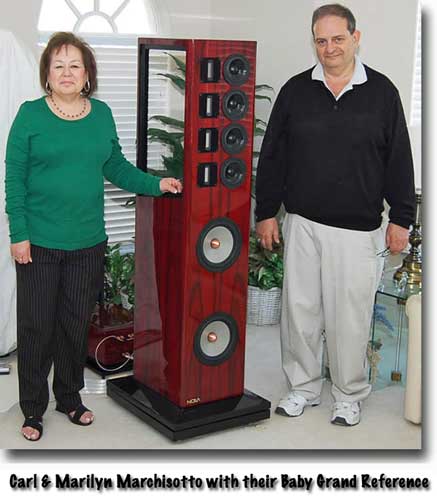 aller 120mm units instead of the 220 mm units used in the Baby Grand.”
aller 120mm units instead of the 220 mm units used in the Baby Grand.”
Because
you are an avid Stereomojo follower, you know what “open baffle” means,
don't you? In an open baffle speaker, the drivers are mounted like a
conventional speaker, but there's no box built around them. They operate
in open air which has many advantages that we have 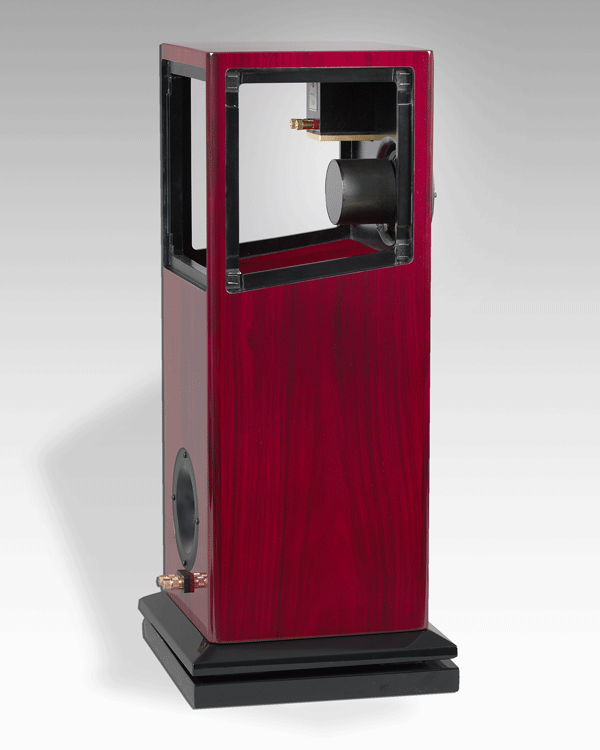 discussed
before, but probably the biggest factor is that they become a dipole
and like a planar speaker and project sound to the rear as well as the
front. In addition, that also eliminates one of the biggest obstacles
speaker designers have to overcome and that's cabinet resonance. Open
baffle means there is no cabinet and thus no cabinet resonance. It also
prevents enclosure panel resonance, air column resonance, which is
caused by air trapped within a closed cabinet. Air column resonance is a
source of standing waves, which color sound and distort its transients.
discussed
before, but probably the biggest factor is that they become a dipole
and like a planar speaker and project sound to the rear as well as the
front. In addition, that also eliminates one of the biggest obstacles
speaker designers have to overcome and that's cabinet resonance. Open
baffle means there is no cabinet and thus no cabinet resonance. It also
prevents enclosure panel resonance, air column resonance, which is
caused by air trapped within a closed cabinet. Air column resonance is a
source of standing waves, which color sound and distort its transients.
Delayed resonance is eliminated as well. Delayed resonance is caused by
sound pressure that has radiated into a cabinet from the rear of a
speaker driver and remains there until, after a delay, it’s
re-transmitted into the listening room. It can cause sonic smearing,
which is most obvious in the midrange, a part of the frequency spectrum
to which the human ear is particularly sensitive.
A fourth form of resonance that closed cabinets can cause occurs when the stiffness of air compressed inside them changes a driver's resonant frequency, bringing it too near the operating range of the driver. That, too, colors the midrange. As for dipolar midrange and tweeter operation, Carl is convinced it’s essential for lifelike reproduction. After all, he points out, voices and instruments don't project sound in one direction only. Dipolar speakers radiate sound from the same diaphragm forward and rearward in a time-coherent manner. But, because their front and back waves are out of phase, they cancel sonic energy that would otherwise be propelled laterally toward side walls, up toward the ceiling and down toward the floor.
It is however fair to point out that the bass drivers are not going commando, but are a more conventional ported cabinet design. The vent is an oversized, double flared design to eliminate port noise. Of course, there's actually a very small percentage of music that travels down as far as the woofers, the vast majority being produced in the midrange and treble. But what little is there is important, giving a solid foundation to the music, just as bass instruments do to real orchestrations and ensembles.
Overall, the driver complement consists of two magnesium woofers, one alnico magnet open baffle midrange and one open baffle true ribbon tweeter in a 3½ way design. The driver array utilizes a 45° mirror-imaged array for the midrange and tweeter.
Also like the Baby Grands, the rich real rosewood cabinets are bathed in perhaps the richest looking high polished lacquer you are ever likely to see. The cabinets seem to produce a glow all by themselves. Just gorgeous. The cabinets are attached to a likewise lacquered black beveled base, but the southernmost parts don't end there. You see, Carl hates resonance, vibration and every other member of their dastardly family. His designs always incorporate maximum isolation to eliminate all those nasties as much as possible. In this case, he employs a double plinth technique that conceals four channels cut into the two platforms where four steel ball bearings precisely fit. When the upper part is set atop the lower, the speaker then floats on the four ball bearings providing a high degree of isolation from vibration resulting in low coloration and distortion. The same design was used in the Baby Grands except an additional third platform was added.
While Carl calls these speakers “Micro”, you won’t be setting them next to your computer monitor. They are 26" H x 11.5" W x 11.5" D with the bases. You’d need to perch them on a good pair of stands which would raise their height to 43”.
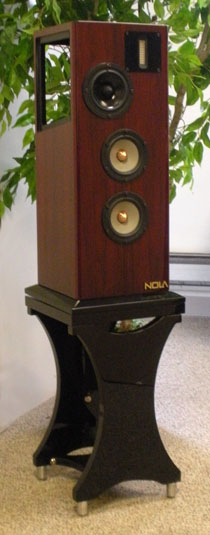
TAKING A STAND
Remember though that Carl HATES anything that compromises the purity of his speakers, so the diabolical designer doesn't stop there. He commissioned his lovey, talented and charming daughter Kristen to design a special stand for his baby Micros they call the “Micro Grand Reference Stand”. Hey, it rhymes! The isolation platform from the Micro is bolted to the top of the stand. The ball bearings are placed in the races of the isolation platform and the speaker with its base attached is placed on the ball bearings. The premium spike feet supplied are screwed into the bottom of the stand. Carl claims that the stands will improve the sound in the areas of transparency, mid range resolution, dynamics, openness, sound staging, depth of field and bass articulation. They are finished in the same piano black and are 17 inches high, the optimal height for the speakers.
Even though the speakers had significant hours on them, I let them cook for another 50 before serious evaluation began. On a side note, I have yet to review a speaker that did not change to some degree after inserting them in a system, even some with thousands of hours on them. I am firmly convinced that any component needs to settle into a system no matter how long it has lived in a different one. I can't prove that scientifically, but there are least a few others that agree.
I recall one conversation with Bobby Palkovic, head sorcerer of Merlin Speakers that confirmed my theory by recounting a story of getting one of his speakers back from a reviewer where they sounded extremely bright and rather tinny, so much so that he thought they had been damaged in shipping. He checked them out and could find nothing wrong. However, after a few days of playing them in his studio they returned to normal. He later found out that the reviewer had used a solid-state amp that was famous for sounding very bright and stringent. “Electronics have a memory," he smiled. He went on to tell me about electron flows and capacitor values and several other things, most of which went right over my head, but he certainly added credence to what I have experienced for years.
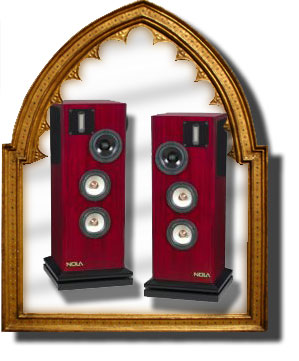
I originally set the Micros up in the small listening room that is 10 x 12 x 9'. For power I used the outstanding Audio Space Reference 3.1 300 B Integrated that puts out 21 W per channel in a Triode-Class A Push-Pull design. I know Carl likes this amp a lot because he heard it with the big Baby Grands in my home. The combination was as striking as it was in the big room with the Baby's - with one difference. While the speakers played moderately loud, perhaps an average of 85 dB, dynamic music caused some audio strain on the amp. Playing typical contemporary pop or rock whose peaks are squashed by limiters and compressors was okay, but I don’t use much of that for reviews. The Audio Space distorts very politely when driven too hard, but it's not something to which you want to listen for long periods.
Now you might be asking, if the same amp drove the bigger speakers in a
bigger room, why would it not do even better with smaller speakers in a
smaller room? That’s a great question – we have smart readers! The
answer is that the Micros are 3 dB less sensitive than the Baby’s. That
doesn't sound like much, but remember that you have to double the
amplifier’s watts to get a 3-db increase  in
sound output. Therefore, if 20 watts will produce a clean 80 dB, it
takes double the output or 40 watts to get just 83 dB in sound output.
Capisce? I asked Carl about the lower sensitivity rating (not efficiency
rating, that’s a different thing) to which he replied astutely, “The
sensitivity of a loud speaker is related to the bass extension and size.
That is for a given bass extension, smaller size will produce lower
efficiency-hence the 86 dB rating. For comparison, the Baby Grands are
89 dB. Now we also chose not to “cheat" by increasing sensitivity by
reducing impedance. So the Micros are 8 ohms over most of the range
dropping to a minimum of 4 ohms. This allows the speaker to be used with
any type of high quality amp including tube designs. Most other designs
are 4 ohm with a min of 2 ohms which is why this type of design needs a
high current amp despite a high rated sensitivity”.
in
sound output. Therefore, if 20 watts will produce a clean 80 dB, it
takes double the output or 40 watts to get just 83 dB in sound output.
Capisce? I asked Carl about the lower sensitivity rating (not efficiency
rating, that’s a different thing) to which he replied astutely, “The
sensitivity of a loud speaker is related to the bass extension and size.
That is for a given bass extension, smaller size will produce lower
efficiency-hence the 86 dB rating. For comparison, the Baby Grands are
89 dB. Now we also chose not to “cheat" by increasing sensitivity by
reducing impedance. So the Micros are 8 ohms over most of the range
dropping to a minimum of 4 ohms. This allows the speaker to be used with
any type of high quality amp including tube designs. Most other designs
are 4 ohm with a min of 2 ohms which is why this type of design needs a
high current amp despite a high rated sensitivity”.
Since one doesn’t really need to listen at high levels in a small room
when the speakers are only about 6’ from one’s ears, I had no problem
with 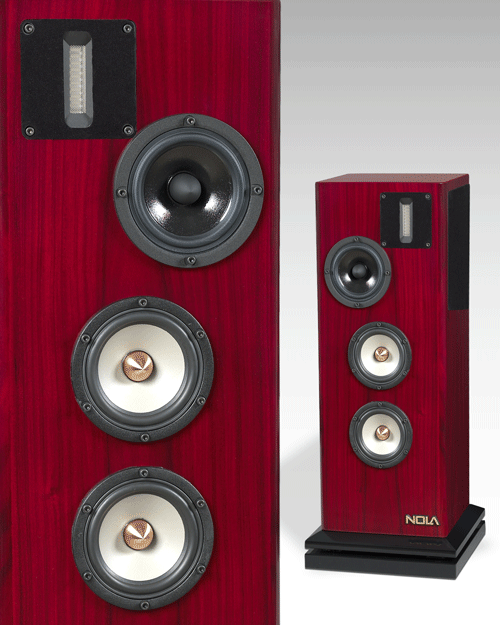 the
combo. I set the Nolas up in the same place as usual, about 3 feet from
the back wall and 7 feet apart. No toe-in. Also as usual, I started out
with the tried-and-true Stereomojo Ultimate Evaluation Disk. (There’s a
link to it on the home page). Now I had heard these speakers at the
Rocky Mountain Show, so I knew that they had plenty of low bass, but I
wasn’t prepared for the LOOOOOW bass I heard initially. Not only was it
low, it was loud! Too loud. With a just a little adjustment in
placement I was able to even things out much more, but frequencies
below, oh let’s say about 200 Hz, were still a little on the hot side.
In this day and age, it is not unusual for small speakers with small
drivers to produce bass that just a few years ago would have been
unimaginable, but even so these were surprising. Not only in the amount
of lowness they produced, but the quality as well.
the
combo. I set the Nolas up in the same place as usual, about 3 feet from
the back wall and 7 feet apart. No toe-in. Also as usual, I started out
with the tried-and-true Stereomojo Ultimate Evaluation Disk. (There’s a
link to it on the home page). Now I had heard these speakers at the
Rocky Mountain Show, so I knew that they had plenty of low bass, but I
wasn’t prepared for the LOOOOOW bass I heard initially. Not only was it
low, it was loud! Too loud. With a just a little adjustment in
placement I was able to even things out much more, but frequencies
below, oh let’s say about 200 Hz, were still a little on the hot side.
In this day and age, it is not unusual for small speakers with small
drivers to produce bass that just a few years ago would have been
unimaginable, but even so these were surprising. Not only in the amount
of lowness they produced, but the quality as well.
Dean Peer, one of the world’s greatest bass players whose “Ucross” CD
has long been an audiophile favorite and containing one of our long
standing evaluation cuts, recently sent me his newest release
“Airborne”. 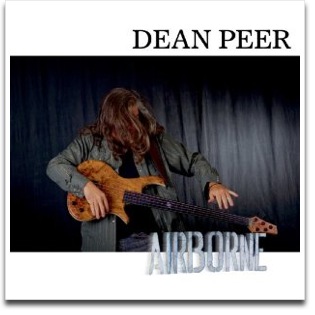 “Ucross”
features Dean playing his bass solo, but on “Airborne” he adds a
drummer. I think the new album is his best since “Ucross” and has gotten
regular spin time since it arrived. Dean uses many studio effects that
often make his bass sound like anything but a bass guitar; everything
from strings to heavy synthesizer patches. There is a tremendous amount
of texture and detail as he plucks and snaps the strings, firing off
crazy transients and tone colors. The Micro Grands not only reproduced
the sometimes subharmonic frequencies, but also all the nuances and
kaleidoscopic tone colors of the bass as well as the very artfully
played drums and percussion.
“Ucross”
features Dean playing his bass solo, but on “Airborne” he adds a
drummer. I think the new album is his best since “Ucross” and has gotten
regular spin time since it arrived. Dean uses many studio effects that
often make his bass sound like anything but a bass guitar; everything
from strings to heavy synthesizer patches. There is a tremendous amount
of texture and detail as he plucks and snaps the strings, firing off
crazy transients and tone colors. The Micro Grands not only reproduced
the sometimes subharmonic frequencies, but also all the nuances and
kaleidoscopic tone colors of the bass as well as the very artfully
played drums and percussion.
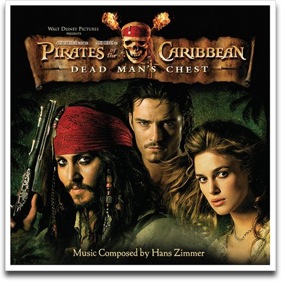
Carl told me, “The special bass drivers have very low distortion--on the
order of 0 .1% and use the same magnets and low distortion magnetic
design as the larger Baby Grand woofers. A large double flared rear
firing port eliminates turbulent air flow distortion. The woofer
crossover board utilizes the same flat wire premium inductors utilized
in the Baby Grand. All of these things plus the special enclosure
construction contribute to the solid, deep clean bass”.
I later switched to my Roger Sanders Magtech that puts out 500 wpc at 8
Ohms and 800 at 4. I wanted to see how well the little woofers performed
with some serious juice applied. Many smaller stand- mounts simply fall
apart at levels approaching 100 dB and above. The shape of their
woofers cones distort when attempting to produce those sound waves that
are several feet long resulting in distorted sound, sometimes even
bottoming out. That’s why designers use materials that are exceptionally
stiff like Kevlar, diamond dust infused paper, aluminum and all manner
of high-tech materials to keep the cones from deforming. Carl uses a
custom magnesium design. It works. During the Baby Grand review he
introduced me to the “Pirates of the Caribbean” soundtrack which is one
of the most torturous tests of woofers with the thunderous, growling,
double bass viols it features. The “Kraken” track builds up and up until
all hell breaks loose when all the orchestra comes together in a
tumultuous tutti at the climax. Lesser speakers get very compressed and
congested trying to deal with the chaos, but like the big Babys, the
Micros just sailed right along, never flagging a bit when things got
rough. In other words, the things play loud, clean and accurate with no
strain from top to bottom.
We’ve spent a lot of time talking about the bass, but what about everything else? Well, I can tell you this: I mentioned hearing these speakers at the Rocky Mountain Fest in Carl’s room. What I didn’t say is that he had a pair of the Micros set up right in front of the Baby Grands (see picture below). The big pair was the same demo pair that we used for the review. Perhaps more than any other reviewer at the show, I was more intimately familiar with their sound. Carl did a little slight-of-ear demo by playing the smaller Micros while talking about the bigger pair, then revealing that the group was actually listening to Micro’s, not the big towers. Invariably, the comments, accompanied by raised eyebrows and confused expressions, were “You’re kidding….no way….what the blank…” followed by everyone getting up and walking around the setup making sure there was no subterfuge at work. Or subwoofer, either.
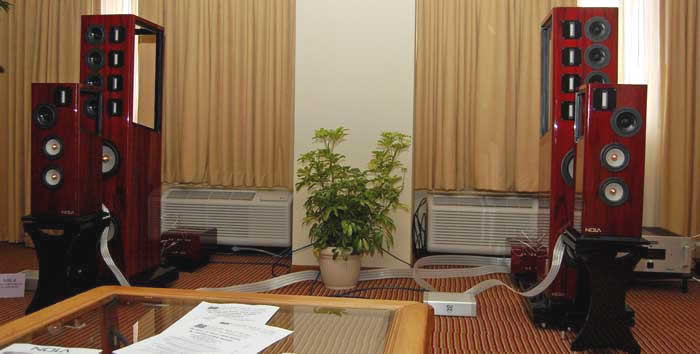
After the Micro Grands were evaluated in the small room, I moved them to
large room, the same venue that had hosted the other Nola reviews. I
know Carl designed these to be used in smaller rooms, but let me tell
you they sounded just as comfortable in Room A as did the Baby Grands.
In the Baby Grand review, I said this: “ I did not have the Baby Grands
for long; they had an appointment at CES that cut my time with them
short. I did have an opportunity to share them with some friends and
family who vary from avid audiophiles to those who could not care or
know less about audio gear. The one overriding comment always elicited
was “Wow! The music sounds so REAL!” I could not say it better in a
thousand words. They were also amazed that no matter where they sat,
even off to the sides of the speakers, a stereo image was heard with
detail and depth. If you listen with a partner, these will be perfect.
There was never a sense of etching or a single note surrounded by
electronic or artificial artifacts. They never glared or beamed whether
the music being played was AC/DC’s latest “Black Ice” on vinyl (oh the
Baby Grand’s adore vinyl!) or early jazz recordings where the engineer
panned instruments hard left and hard right to accent the then new
stereo format. Usually those sound very boxy like the player was
standing inside the speaker. None of that here.
So we’ve established that the overall character of the Micro Grand is more than a little similar to the $55,000 Baby Grand models. But there’s much more to the Nola sound than frequency response, wide dynamics and tonal accuracy. I mean, other great speakers do all that, too. For me, and everyone else who has listened to Carl’s masterpieces, what sets them apart is their uncanny ability to add (or reveal) an amazing sense of liveness to recordings. Some speakers seem to deliver a sense of bringing the musicians into your room. Nothing wrong with that. But, the Nola’s open baffle along with Carl’s expertise (the man has some serious ears on him) accomplishes quite the opposite; they impart a quality that’s much more of “you are there”, and I mean really there. More than any other speaker brand – even other dipoles and electrostats. I once asked Carl what his favorite recordings are. Guess what; they were all live recordings.
Yes, there are other speakers that will take a live recording and
bring you into the live experience as well. The thing is however, the
Nolas bring much more of a live feel, and visual, to recordings that
were made in a studio. Even those where individual tracks were laid
one-at-a-time and the real ensemble, all the players playing together in
a real performance, never took place. Perhaps you don’t know, but many
recordings th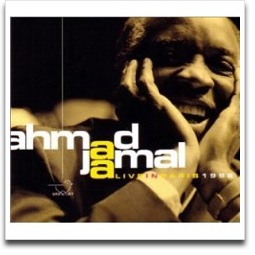 ese
days are done in multiple studios with different musicians adding
tracks while never even seeing another player. It’s easy with ProTools.
You just send the digital files over the net, the engineer cues them up,
clicks “record” on a new track and away you go. And yes, even those
type gain a new sense of being transported to another place. Not nearly
as much as a true live recording of course. There are two different
types of “live” recordings, one being the kind that are recorded where
there’s an audience at say, Meyerson Hall in Dallas, or at the Blue note
in NY. But there’s also the “live in studio” kind where mics are set up
and the band plays just as if there were an audience. Both types are
where the Nolas, no matter which model, take wings.
ese
days are done in multiple studios with different musicians adding
tracks while never even seeing another player. It’s easy with ProTools.
You just send the digital files over the net, the engineer cues them up,
clicks “record” on a new track and away you go. And yes, even those
type gain a new sense of being transported to another place. Not nearly
as much as a true live recording of course. There are two different
types of “live” recordings, one being the kind that are recorded where
there’s an audience at say, Meyerson Hall in Dallas, or at the Blue note
in NY. But there’s also the “live in studio” kind where mics are set up
and the band plays just as if there were an audience. Both types are
where the Nolas, no matter which model, take wings.
There are so many great ones. “Friday Night Live in San Francisco” with three great guitarists in front of an audience, James Taylor’s “Live at the Beacon”, Neil Young’s “Live at Massey Hall”, Ahmad Jamal’s several live recordings (Carl turned me on to those) and on and on. Nothing in my experience matches the Nola’s presentation of live recordings
In addition, my wife Linda loves the elegant look of the polished rosewood, but also the fact that the Nolas do not have a narrow sweet spot like some other types. She can sit to the right and still hear a perfect stereo image. That’s important if you have a significant other. I think a lot of times the reason our wives don’t like to sit and listen like we do is because they often only hear mostly one channel since we tend to hog the center.
Now. As you know, Stereomojo doesn’t just exalt a product’s strengths; we also examine its weaknesses. In this case, the Nola’s weakness is also one of its greatest strengths – the “live” character of its presentation. Some folks just don’t cater to that. There was an encounter with one famous hi-end electronics designer who said to me as he exited the Nola room at a show, “Have you heard these Nolas yet? Don’t they sound like crap?!” I happen to know that this guy, one for whom I have great respect, loves the sound of full-range horn speakers. Those type couldn’t be more dissimilar than the open baffle Nolas. Some people prefer a very dry, ultra detailed, up front image. The Nolas tend to place the sound a little to the rear of the speakers. Very deep, very wide, very layered, but more recessed than some others. Maybe you want Steely Dan to sound more like they are playing in your room than you being at the recording session. There’s nothing “wrong” with either preference. It's our job to describe as fully and accurately what we see, hear and feel, not to sell you on our preferences.
One other note, while there are black cloth covers for the sides and rears of the open baffles (I never used ‘em), the drivers on the front are unclothed.

At $14,000 per pair plus stands ($1,200), the Nola Micro Grands are not cheap, but they don’t look or sound cheap, either. We can safely say they sound and look more expensive than many stand mount and floorstanding speakers we’ve heard. Some much more expensive like the aforementioned Magicos. Mr. Marchisotto’s goal of making them sound like his $55,000 Baby Grand models in a much smaller and cheaper package seems to have been met. While the tower speakers would not work in a small room, the Micros will work there as well as those more moderate sized.
Amplifier matching, as always, is important. The Micro’s sensitivity is listed as 86 dB, though their benign impedance curve makes them easier for amps to drive. Specifically, in a medium room say 15 x 10 x 8 feet, we’d use at least a 30-40 watt push pull tube amp. Probably 60 watts minimum for normal solid state with a strong, fully regulated power supply. Those are minimums. If you have more juice, that’s fine. SET’s need not apply.
The tasty polished rosewood is standard, but other finishes are available at additional cost. NOT available at any cost are front speaker grills. You’d better like your drivers naked.
If you like your music to sound like a live performance, you will not find a better speaker than anything by Nola. If, like Carl, you like to listen to recordings that were caught live, the Nola line is your best choice. If you prefer something else, then you should buy something else. It’s really that simple. Nola does make a full line of speakers at different prices, but they all have the Nola sound.
